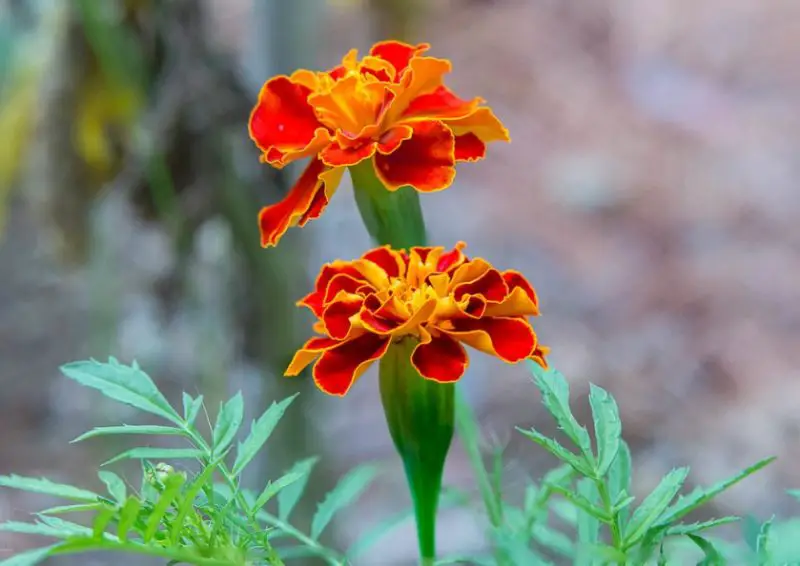Marigolds (Tagetes spp.) are among the most reliable and popular bedding flowers in gardens around the world. With their bright, cheerful blossoms in shades of yellow, orange, and red, these flowers are a must-have for any garden enthusiast. Their fern-like foliage and ability to thrive in various conditions make them a favorite among gardeners.
Whether you’re a beginner or an experienced gardener, this Marigold Flowers Care and Growing Guide will provide essential tips for growing these lovely blooms in your garden.
Overview of Marigolds (Tagetes spp.)

- Common Name: Marigold
- Botanical Name: Tagetes spp.
- Family: Asteraceae
- Plant Type: Herbaceous, Annual
- Mature Size: 4–48 inches tall, 6–24 inches wide
- Sun Exposure: Full sun
- Soil Type: Well-drained, evenly moist
- Soil pH: Slightly acidic to neutral (6.0 to 7.0)
- Bloom Time: Summer
- Flower Colors: Yellow, orange, white, red, gold, bicolor
- USDA Hardiness Zones: 2-11 (annual in all zones)
- Native Area: Southern North America (Mexico)
Now that we have a general understanding of marigolds, let’s dive into the specific care and growing tips that will ensure your marigolds bloom beautifully all season long.
Marigold Care Tips
Light Requirements
Marigolds thrive in full sunlight. To encourage robust growth and abundant flowering, plant your marigolds in a location where they can receive at least six to eight hours of sunlight per day. In areas with partial shade, marigolds may become leggy and produce fewer blooms. The more light, the better the performance of these resilient plants.
Soil Requirements
Marigolds are not picky about soil quality. However, they do best in well-drained soil with a pH between 6.0 and 7.0, which is slightly acidic to neutral. They don’t require rich, organic matter for growth and may even perform better in soil that is lean and not overly fertile. Rich soils can lead to excess foliage growth at the expense of flowers.
Watering
Newly planted marigold seeds or young plants need consistent moisture to establish strong roots. Ensure that the soil remains moist during the initial growing stages, especially during hot and sunny weather. Once they’re established, marigolds become fairly drought-tolerant, though they will bloom more prolifically if watered weekly. Avoid overwatering to prevent root rot.
Temperature and Humidity
Marigolds are heat-loving plants, thriving in temperatures that suit USDA hardiness zones 2 through 11. They can handle the heat of summer, but they may slow down flowering during extreme heat. As the weather cools in late summer and fall, flowering usually resumes with greater vigor. In terms of humidity, marigolds can handle a wide range of conditions but may develop powdery mildew in overly humid environments. Planting in full sun and allowing airflow between plants will reduce this risk.
Fertilizing
One of the advantages of growing marigolds is that they don’t require much in the way of fertilizer. Too much fertilizer can actually reduce flowering, as the plant will focus more on producing lush green foliage. Regular deadheading (removal of spent blooms) is often all that’s necessary to keep them flowering profusely.
Types of Marigold
There are several species and cultivars of marigolds, each offering unique characteristics in terms of size, flower form, and bloom color. The three most commonly grown varieties are:
African Marigolds (Tagetes erecta)
Also known as Mexican marigolds, these marigolds boast large, pom-pom flowers that can reach up to 4 inches in diameter. African marigolds are tall, sometimes growing up to 4 feet, and are often used as border plants or for cut flowers. Their colors typically range from yellow to orange.
French Marigolds (Tagetes patula)
French marigolds are more compact, typically growing to heights between 5 and 18 inches. They are known for their long bloom period and the bushy nature of the plants. French marigolds feature double flowers that can be yellow, orange, or mahogany, and they thrive in containers as well as garden beds.
Signet Marigolds (Tagetes tenuifolia)
Signet marigolds stand out due to their edible blooms and lacy foliage. These marigolds are smaller, with daisy-like flowers in shades of yellow and orange. Common cultivars include ‘Orange Gem’ and ‘Lemon Gem’. Their delicate appearance and small stature make them ideal for edging garden beds or planting in herb gardens.
Pruning and Deadheading for Continuous Blooming
To keep your marigolds producing vibrant blooms throughout the growing season, pruning and deadheading are key. Removing spent blooms (deadheading) encourages the plant to redirect its energy toward producing new flowers rather than seed production. If your marigold plants become leggy or sparse, especially during the peak of summer, you can prune them back to promote bushier growth.
Pinching back the early flower buds can also stimulate more branching and produce a more dramatic display of flowers later in the season. Don’t be afraid to trim your marigolds to help them thrive.
Propagation and Growing Marigolds from Seed
Marigolds are incredibly easy to propagate, especially from seed. In fact, many gardeners choose to grow marigolds directly from seeds because they germinate quickly and grow rapidly. For earlier blooms, start your marigold seeds indoors 6-8 weeks before the last frost. Once the seedlings have grown and the danger of frost has passed, transplant them into your garden.
Alternatively, you can direct sow marigold seeds into the garden. These plants are so vigorous that they often self-seed, meaning you may find new marigolds sprouting from last year’s plants without any additional effort.
Steps for Starting Marigolds from Seed:
- Sow seeds on the surface of the soil and cover with a light layer of vermiculite.
- Keep the soil consistently moist, and place the seed trays in a warm area.
- Once the seeds sprout (typically within 4-5 days), move the seedlings to a bright location with good air circulation.
- Transplant the seedlings outdoors when they are strong enough and after frost danger has passed.
Common Problems and Pests in Marigolds
While marigolds are generally hardy and pest-resistant, they can still experience a few common problems:
Slugs and Snails
These pests may feast on the leaves of young marigold plants. Prevent damage by removing leaf debris and using slug traps if necessary.
Aphids
Aphids can sometimes infest marigold plants, especially during humid weather. They can be easily controlled with horticultural soaps or oils.
Powdery Mildew
Powdery mildew is a fungal disease that can develop during damp or humid conditions. To prevent this, ensure proper air circulation around your marigold plants and avoid overhead watering.
Damping-off Disease
Seedlings may sometimes suffer from damping-off, a fungal disease that causes the stems to blacken and collapse. To prevent this, use sterile soil and keep the soil warm.
Top Tips for Growing Healthy Marigolds
- Plant in Full Sun: Maximize blooming by planting your marigolds where they’ll receive at least six hours of sunlight daily.
- Deadhead Regularly: Remove spent blooms to encourage continuous flowering throughout the season.
- Avoid Overwatering: Once established, water your marigolds sparingly, as they are drought-tolerant.
- Use Lean Soil: Marigolds do better in soil that isn’t too rich in nutrients. Over-fertilization can result in lush leaves but fewer blooms.
- Pinch Back Early Buds: Promote bushy growth and more flowers by pinching back early buds.
With these simple but effective tips, your marigolds will thrive and bloom profusely all summer long, adding beauty and color to your garden. Happy planting!






